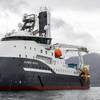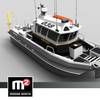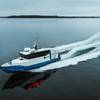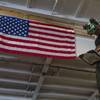Japan retains its perch atop the world commercial shipbuilding heap, although its position grows increasingly precarious with the continued emphasis on shipbuilding market share by its Korean competitors, and the emergence of low-cost, hungry start-ups in China and the former Eastern bloc nations.
The challenges facing the Japanese shipbuilders and ship equipment suppliers are not unlike those faced by its European counterparts during much of the past decade. While Japan's strong suit continues to be its ability to mass produce tankers and bulk carriers in a very efficient and profitable manner, its technical prowess and continually refined manufacturing procedures can only take it so far in what continues to be a labor intensive process. The proliferation of and widespread incorporation of advanced shipbuilding CAD/CAM/CAE systems continues to level the playing field, as upstarts and industry veterans alike are a major investment away from drastically increased efficiencies.
While the balance of power in commercial shipbuilding continues to tip away from Japan, the home countries' voracious appetite for new ships continues to drive new business.
In fiscal 1998 (the last official statistics available at press time), new orders received by Japanese shipbuilders totaled 283 vessels equaling 10.5 million gross tons, a decrease of 35.4 percent in the number of vessels and 21.4 percent in GT from FY 1997. Dry Cargo (5.7 million GT) and Tankers (4.8 million GT) dominated the newbuild orderbook, with just 36,000 GT dedicated to the category "other." Worldwide, it is worthy to note, orders for newbuildings worldwide were 26.7 million GT, down 10 million GT from 1997.
Even more telling is the value of ship machinery produced and exported. Of the nearly 870.1 billion yen ($6.8 billion) of ship machinery produced in 1998, a dominating $6.4 billion worth was manufactured for use in Japan. In comparison, Japanese shipbuilders imported a scan (in comparison) $184 million worth of ship machinery in 1998, a decline of seven percent from the year before, according to figures from the Japanese Marine Equipment Association.
While the Japanese ship equipment supply business is clearly dominant on its home grounds, the recent deterioration of newbuilding activity has left the collective industry — which boast approximately 775 factories and about 35,000 workers — with some notable problems of its own. For example, the proliferation of low-cost competitors and stagnation of R&D activities has weakened the very foundation of the Japan ship machinery industry. In an effort to reverse this trend, there has been a recent upsurge in the vitalization of R&D activities within these vital manufacturers, with the realization that the new market realities include shortages of both skilled workers and engineers, coupled with fewer funds earmarked for R&D. The call has also been sounded for manufacturers to immediately strengthen its cost competitiveness by modernizing production facilities and improving productivity through additional automation and procurement of low-cost materials, as well as the reduction of the number of parts used in machinery and equipment.
JAMSTEC Deepsea Exploring Ship Contract Announced
Japan Marine Science and Technology Center (JAMSTEC) will build a deep sea exploring ship for the Integrated Ocean Drilling Program (IODP) and has signed a contract with Mitsubishi Heavy Industries, Ltd. (MHI) for the basic design of the deep sea exploring ship and with Mitsui Engineering & Shipbuilding Co., Ltd. (MES) for the dynamic positioning system (DPS) and ship systems. IODP is an international program carried out by the U.S., Japan, and other participating nations. The program targets studies on the earth and life science through exploring changes in weather, mechanisms of change deep in the earth, unknown living organisms in deep seas, and gas hydrates. The ship must be operated in sea areas with water depths of 8,202 ft. (2,500 m) and 13,123 (4,000 m) (in the future) and be capable of drilling deeply to the mantle. The contract for construction of the ship is being drawn up this month, and the ship will be completed in 2004. TSC completes DH tanker Pacific Libra Tsuneishi Shipbuilding Co., Ltd. (TSC) has completed construction of the Pacific Libra, a double-hull Aframax tanker of 106,644 dwt, for Pacific Lily Shipping S. A. of Panama. The new tanker is designed for increased propulsion efficiency. A newly-designed propeller can achieve 15 knots in service speed with an engine output less than that required for the conventional Aframax tanker. The Cu-Fe type anti-adhesion system against marine organisms is installed to prevent adhesion of marine organisms to the hull, as well as hull corrosion. Cargo oil tanks consist of six pairs of tanks and one pair of slop tank (14 tanks), which are separated by the center bulkhead. The total cargo oil tank capacity is 119,055 cu. m. (98 percent), or approximately 748,828 barrels. The OCIMF (Oil Companies International Marine Forum) Ship to Ship Transfer Guide is used to allow cargo handling with other ships. Three types of oil cargoes can be carried at the same time, and double valves installed on cargo lines prevent contamination between cargoes. Three cargo oil pumps with a capacity of 2,500 cu. m. /hr x 135 T.H. are installed.
Automation of the engine room complies with M0 requirements. The seawater cooling pipes for the main engine is lined with polyethylene to protect the pipes from corrosion. Auxiliary boilers can burn A-type heavy fuel oil for preservation of the environment.
Subscribe for
Maritime Reporter E-News
Maritime Reporter E-News is the maritime industry's largest circulation and most authoritative ENews Service, delivered to your Email five times per week









